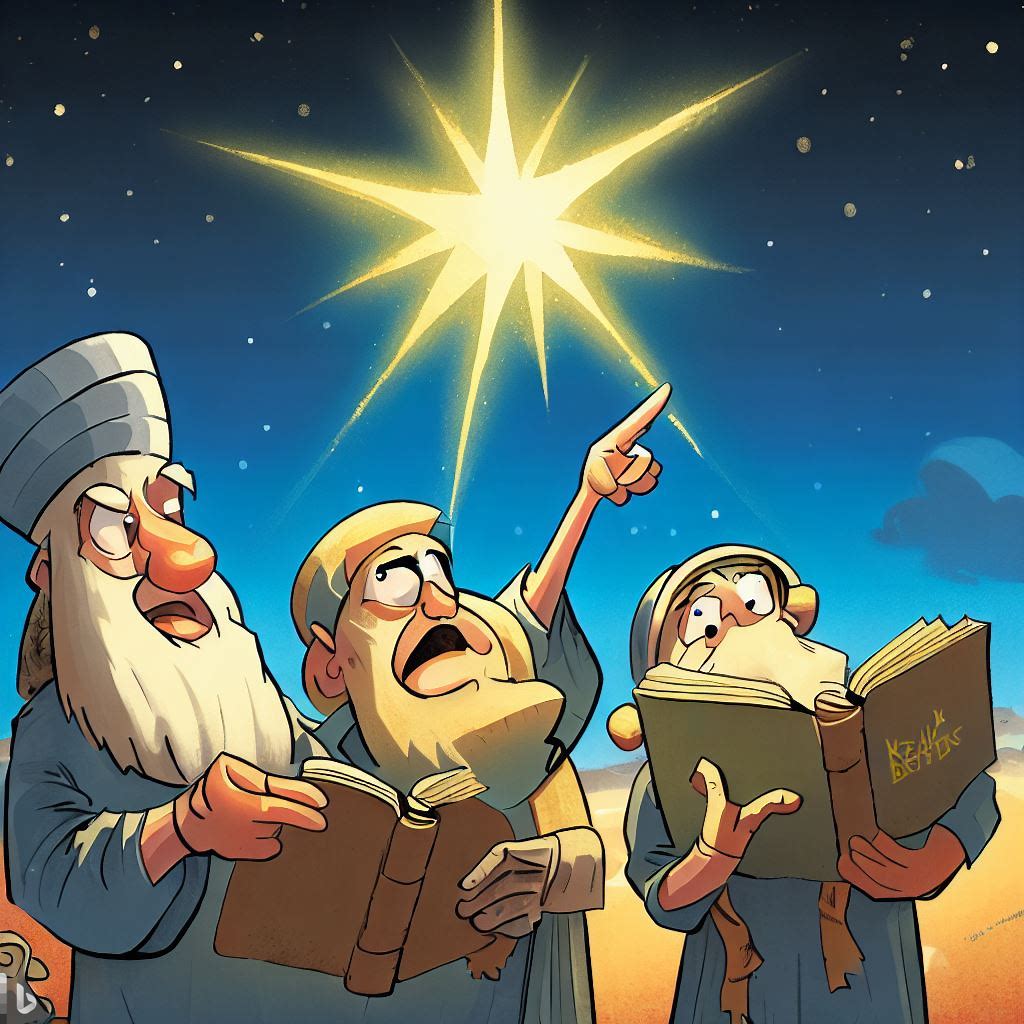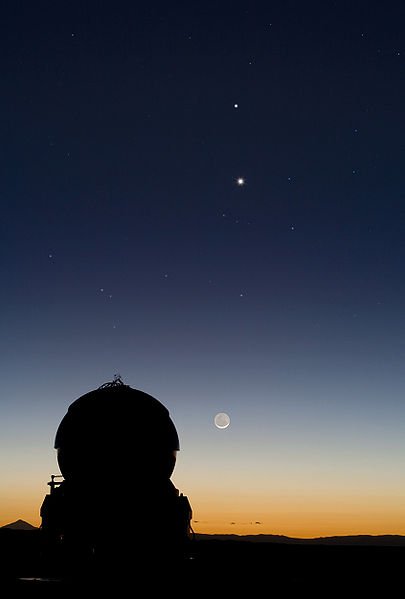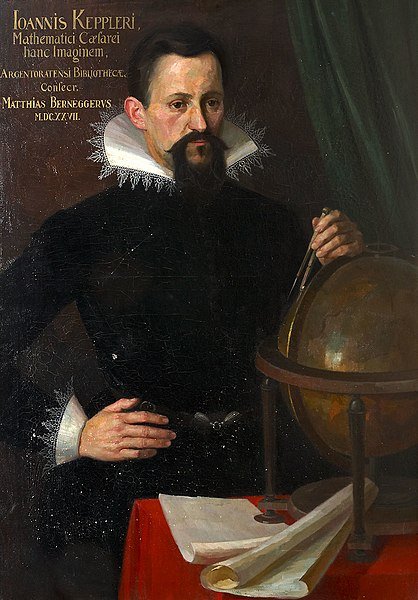On "Jesus is a Wacky Guy" or Rather a Critique of a Popular Science Video

EN
I recently watched a short Youtube video from the channel Date un Vlog of the Spanish physicist Javier Santaolalla. The video is titled Jesucrito es un loquillo (Jesus Christ is a wacky guy) and has reached more than a million views . It is in Spanish and I insert it below in case you want to see it:
https://www.youtube.com/shorts/dGHRQRD-DjI
Well, the content of the video has little to do with its title, as far as I can see, so don't think it's a video from some troll. It is more of an educational video that talks about the Star of Bethlehem and how Kepler, a 16th century astronomer, proposed a scientific explanation for this celestial phenomenon.
However, surrounding this central theme, the video makes a series of statements that strongly call my attention, especially since the author attributes the character of scientific and historical to them. I have already left a comment on his video, but in this article I intend to delve a little deeper into my appreciation and criticism of all this. Let's start:
When was Jesus of Nazareth born?
Santaolalla says in his video that:
This answer can be made accurately thanks to historical records and science [emphasis mine].
Acknowledging that proven historical data, such as the reign of Herod and Pontius Pilate, are helpful, but still rather imprecise, he says that science appears to settle this question and proceeds to discuss the idea of planetary conjunction, which I will address later. But already at this point in the video there are things that need to be commented on.
First of all, it is clear that he is talking about Jesus of Nazareth, referred to in the video as Jesus Christ. While it is true that the character is given the alternate names or titles of Jesus Christ and Christ, the latter terms could carry a Christian and religious connotation. I speculate that the author decided to use them for marketing purposes. The name Jesus of Nazareth (or simply Jesus) is a bit more neutral to talk about the historical character.
Secondly, regarding the birth of Jesus of Nazareth, there are a couple of accounts: one contained in the book known as the Gospel of Matthew and another in the book known as as the Gospel of Luke. Curiously, only the Gospel of Matthew speaks of the event of the star of Bethlehem.

⬆️ AI doing its best to represent the star of Bethlehem and some skeptical astrologers AI public domain image
The problem occurs when Santaolalla presents these gospels as historical records. But, from an academic point of view, does that term do justice to those writings?
Actually, the topic is a bit debatable, since we are talking about sacred texts of active religions and I suppose that there are things that depend on how you define historical record and the audience to whom the content is directed. But the video is clearly an educational video that appeals to science and history, which is why, in my opinion, it should be played following the rules of these disciplines, that is, you have to handle the matter objectively and listen to the academy.
Many scholars specializing in these matters are also religious, of course, but there are also many secularists present there. There will be those who lean towards mainstream historicity, even literalist, while others who lean towards mainstream fiction, even mythological.
However, the extremes are the minority positions in academia. I haven't been able to get a survey that shows the trend for certain, but it is observed that the opinion of scholars regarding the genre of the gospels has changed over time: from biographies, stories and old memories, to complex genre and even innovative, etc.
What is clearer, especially among critical scholars, is that the historicity of the gospels is not total or indisputable. They are more like historical literature. As such, they are based on real events, but are presented as narratives.
Historical literature can resort to fiction, which is why it can contain dialogues, scenes and fictitious characters. It can also mention historical data either contemporary with the writing or prior to it.
The object of historical literature is not to report events and describe them as objectively and neutrally as possible. Its purpose is rather to convey a vision or interpretation of the facts and thereby provide a lesson. It is like making a story or a novel from real events. Historical literature is not pure history.
In such a way that the gospels can be partially based on real events or mention real events, but as literary works they have many fictional elements that embellish the narrative, especially elements of a theological and supernatural type, since in the end the gospels also have a religious purpose for their time and historical context. They are stories of faith by and for primitive Christian communities.
Furthermore, on closer examination of the content of the gospels it becomes clearer that they cannot be considered reliable historical sources, such as say scholars like Bart Ehrman. In fact, the very accounts of the birth of Jesus of Nazareth contained in Matthew and Luke have several inconsistent details between them.
For example, Matthew places the birth of Jesus during the reign of Herod, who, according to true historical records, died in 4 BCE, while Luke says that Jesus was born during the Census of Quirinius, which was in 6 CE. The 10-year difference between the two events is historically irreconcilable. The harmonizations offered by the apologists have very little acceptance from a point of view of historical method.

⬆️ A furious Herod because he has to attend the census of Quirinus in several years according to the AI AI public domain
In addition to this detail, there are dozens of other inconsistencies that make scholars mistrust the historical reliability of these texts.
Santaolalla acknowledges the historical inaccuracies, but still is not careful in labeling the gospels as historical records, ignoring their literary genre and the opinion of scholars, and omitting the possibility that much of the content of these gospels is composed, which could include the very episode of the star of Bethlehem.
Indeed, the first logical inference that could be made, based on the fact that the Gospels are historical literature, is that the episode of the birth of Jesus is more easily explained as a literary construction of the legendary or mythological type, as many scholars recognize.
In fact, some scholars say that the historical Jesus was born in Nazareth, but the account of his birth in Bethlehem was a late addition during the composition of the gospel. Others defend the opposite, that Jesus was born in Bethlehem and not in Nazareth.
The fact that there is debate on this issue among relevant scholars suggests that at least we should be cautious when making claims about the historical character of the gospels.
Therefore, it seems reasonable to me that the first logical explanation for the matter of the star of Bethlehem is that it is probably one more element in the literary composition that does not necessarily have a real background, that is, it did not necessarily occur. It is what scholars call pious fiction and is seriously one of the explanations proposed for the Star of Bethlehem and the birth of Jesus according to Matthew. Santaolalla does not offer this possibility as a disclaimer.
Is it true that science in the hands of Kepler has answered the question of when Jesus was born?
Let's go back to the Dateunvlog video. It is commented that, given the problems of historical records to specify when Jesus of Nazareth was born:
This is the point where science comes in.
And he proceeds to tell how the famous German astronomer Johannes Kepler approached the matter. These are the statements of facts in this regard that Santaolalla makes:
- In 1603 Kepler observed a triple conjunction of Mars, Jupiter and Saturn.
- Kepler calculated that such a conjunction occurred once every 400 years.
- According to his calculations, this conjunction must have occurred in the year 7 BCE.
- In that year the conjunction had to be repeated three times, the last being in the month of December.
- This conjunction had a very precise orientation towards the Mediterranean Sea.
- This conjunction occurred in the constellation of Pisces, which the ancient prophecies associate with the arrival of the Messiah.
- With all this, Kepler concluded that it was the Star of Bethlehem.

⬆️ Conjunction of Mercury and Venus, aligned on the Moon, seen from the Paranal Observatory Wikimedia Commons
Like any responsible consumer of science content, I took the trouble to fact-check these claims so I could use them safely. They are informative data, certainly.
However, it has caught my attention that he left out the detail that the conjunction that Kepler observed coincided with the appearance of a nova star. What a coincidence! But it doesn't end there; actually Kepler thought that the triple conjunction spawned the supernova and that was his proposed solution to the star of Bethlehem. I think that Santaolalla should not have omitted that detail.
Ok, even the great astronomers are wrong —I'm talking about Kepler, of course. Today we know that planetary conjunctions do not create supernovae; it doesn't go that far. In any case, currently the nova that Kepler studied has received the name Kepler's Star in honor of the astronomer. This article available on the Harvard website is quite illuminating in this regard. It was surely a spectacular event.
For its part, the matter of the very precise orientation towards the Mediterranean Sea and others is something that can be determined using the Stellarium software. You could check it yourself.
Now, I do want to emphasize that it is not true that Kepler categorically concluded that the calculated conjunction was the Star of Bethlehem, contrary to what the video suggests. The famous astronomer offered the conjunction as one possibility among others; In his book De Stella Nova of 1606, he wrote the following passages regarding the matter:
Therefore, if anyone wants to believe that the star of the Magi was a conjunction of planets, I will not contradict him; but if anyone wants to believe that it was a new star, I will not contradict him either; but if anyone wants to believe that it was a fixed star or a comet, I will contradict him with reasons and arguments.
I cannot deny that this conjunction may have been the star of the Magi, but I cannot affirm it with certainty either.
I do not dare to affirm anything with certainty about the matter of the star of the Magi; but if anyone thinks that it was this conjunction, I will not contradict him.
It is clear that the astronomer did not see that solution as conclusive. In fact, he recognized the limits of his proposal and that his calculated dates for the phenomenon were not relevant from the point of view of available Biblical chronology and Roman history. Kepler says in De Stella Nova:
I found that this conjunction occurred in the year 747 from the foundation of Rome (7 BC), but I could not find any historical or biblical indication for that year; not even a war or a peace between the Romans and the Jews; not even a census or a change in taxes; not even a death or a notable birth. Therefore, I wondered if this conjunction could have been the Star of Bethlehem that guided the magi to the place of Christ's birth.

⬆️ De stella nova in pede Serpentarii (AKA De Stella Nova) - Title page of the 1604 German edition of Kepler's book on these events. Wikimedia Commons
I hope that the dear reader does not think that I am being a little picky with a short popular science video. I am serious about the accuracy of the information being shared. There is a clear communicative intention in the educational video and analytical claims are made that are falsifiable.
Indeed, it is affirmed that science has settled the question of the dating of the birth of Jesus of Nazareth through the work of Johannes Kepler, when it really was not. Neither science nor Kepler have done such a thing.
In the video it can be seen that the month of December is specifically mentioned as one of the months in which the triple conjunction would occur. It may be said because an association is made with the traditional month assigned to the birth of Jesus of Nazareth. But, was Jesus born in December?
In reality the gospels do not specify in which month the birth occurred and the rest of the Greek scriptures do not comment on it either. December 25 as the date of birth of Jesus was a convention adopted by the Catholic Church that dates back to the 4th century when the Emperor Constantine legalized the practice of Christianity in Rome. It is an adaptation of a pagan festival of the Romans dedicated to the god Sol Invictus (Undefeated sun), which took place on December 25.
In fact, there are historians, textual critics and even theologians who have a different opinion and have proposed another month for the birth of Jesus of Nazareth that vary according to the argument, such as September, October, May or June. The month of December may have been mentioned in the video because Kepler might have believed that Jesus was born in December, the traditional month, but I know of no evidence for this.
Finally, I wanted to mention that Kepler's explanation of the Star of Bethlehem is one of several hypotheses; not the currently confirmed or accepted consensus explanation and he himself had acknowledged it. In reality, his hypothesis has limitations such as those posed by astronomer Bradney Schaefer, who claims that the conjunction was neither close nor bright enough to attract the attention of ancient celestial observers.
Some astronomers have proposed other hypotheses for this phenomenon, such as the double occultation of Jupiter behind the moon in Aries, a nova, a comet, etc. I recommend this article from National Geographic that talks about it. Yet the Babylonian and Chinese astronomical records for the time reveal nothing striking enough as the event narrated in Matthew.
The criticism is that it is important to show these alternatives and their limitations and not present Kepler's planetary conjunction hypothesis as the definitive answer, since it is not. This also helps combat confirmation bias.
Furthermore, science may never be able to answer this question, especially if it is given such a supernatural tone as the one related in the gospel, according to which the star moved as the astrologers moved, in addition to the other clearly allegorical details and literary embellishment.
In Summary
We must recognize that we can learn interesting details from this video from the famous Spanish-speaking science popularizer on YouTube. However, as I let the author know, since he is making a video about science and it is understood that it is an educational channel, it would be good if it were more correct, objective and precise at the time to talk about these issues.
Claims that the date of Jesus' birth has been determined very accurately thanks to historical records and that science has come to answer the question through Kepler's proposed planetary conjunction are simply not true. The video has reached more than a million views; it is a broad audience with different levels of knowledge and opinions. It would be nice if these details covered in this article could be offered as an opportunity for dialogue and learning.

Indeed, the discussion about the historical character of the gospels is a complex and debated topic. As you pointed out, they are considered historical literature and not pure historical records. They contain elements of fiction and theological interpretation, making it challenging to determine their historical accuracy decisively. The diverse opinions among scholars further emphasize the need for caution when presenting the gospels as historical accounts.
Regarding Kepler's proposed planetary conjunction as the explanation for the Star of Bethlehem, you highlighted some crucial details that were overlooked in the video. Kepler himself acknowledged the limitations of his hypothesis, and it is vital to present alternative explanations and their limitations to avoid confirmation bias. The historical and astronomical context surrounding the events is essential to consider when discussing this matter.
Your in-depth analysis and criticism of the content are commendable and I appreciate your effort to shed light on certain inaccuracies in the video. In such a broad audience, it is essential to provide information that encourages dialogue and learning rather than presenting definite answers based on incomplete or debatable evidence.
I hope that your feedback will reach the video creator and foster a more informed and nuanced discussion of these historical and scientific topics in the future.
Nice summary.
Thanks for your contribution to the STEMsocial community. Feel free to join us on discord to get to know the rest of us!
Please consider delegating to the @stemsocial account (85% of the curation rewards are returned).
You may also include @stemsocial as a beneficiary of the rewards of this post to get a stronger support.
Create a video response for the video. Make it short and compelling. The general appetite of most people requires a dash of sensational claims, but this could always be reeled back in toward rationality.
Maybe! I'm not into creating videos lately. It's true that these short videos resort to sensationalism often, but sometimes they go too far. Thanks for the suggestion.
I get it. I only suggest this because the average person only has the appetite for video. Hive is one of the exceptions in this regard.